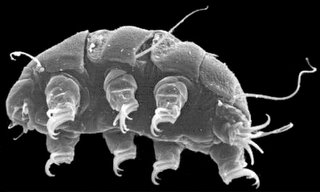

How did I not hear about these little guys before?
"Water Bears" belong to a lesser known phylum of invertebrate animals, the Tardigrada. They are similar to arthropods, which include crustaceans and insects.
Tardigrades are supertiny critters, typically 0.3 to 0.5 mm (For you non-scientists, a millimeter is about the thickness of a dime). They need water, but if the environment is too dry they just go into hibernation…. For up to TEN YEARS! They can also survive staggering amounts of radiation (5700 grays, while five grays would be fatal to a human). Oh, and they can survive being heated for a few minutes to 151 °C or being chilled for days at -272.8 °C (almost absolute zero). How sweet is that?
They have 4 pairs of legs with claws and five body-segments. They move like little bears, with a slow lumbering gait. The first link below has a short video. Tardigrades are found all over the world, including salt and freshwater environments, in humid rain forests and dry deserts, in low canyons and high altitude mountain-tops. Tardigrades are aquatic organisms and need to be in water to eat, breath, reproduce, and move. They are commonly found in the interstitial (water between leaves) environment of moss and lichen. Some tardigrades are carnivores, others are herbivores or omnivores. They feed on each other, as well as mites, aphids, nematodes, and other microscopic organisms. These microscopic creatures play an important role in the cycling of nutrients. And they’re really really cute.
More reading:
http://www.tardigrades.com/
http://www.iwu.edu/~tardisdp/tardigrade_facts.html
http://en.wikipedia.org/wiki/Tardigrade
Want to help pay my tuition while wearing coolness? http://www.cafepress.com/tardigrades
No comments:
Post a Comment